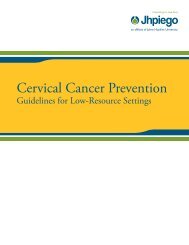Manual for Male Circumcision under Local Anaesthesia
Manual for Male Circumcision under Local Anaesthesia
Manual for Male Circumcision under Local Anaesthesia
You also want an ePaper? Increase the reach of your titles
YUMPU automatically turns print PDFs into web optimized ePapers that Google loves.
<strong>Male</strong> circumcision <strong>under</strong> local anaesthesia<br />
Version 3.1 (Dec09)<br />
SAFE HANDLING OF HYPODERMIC NEEDLES AND SYRINGES<br />
All clinic staff should be trained in the safe handling of sharp instruments.<br />
Single-use autodisable syringes with integrated needles are safer<br />
because they cannot be used again, but are expensive. Hypodermic<br />
(hollow-bore) needles are the most common cause of injuries to all types<br />
of clinic workers:<br />
• Health care workers are most often stuck by hypodermic needles<br />
during patient care.<br />
• Cleaning staff are most often stuck by needles when washing<br />
soiled instruments.<br />
• Housekeeping staff are most often stuck by needles when<br />
disposing of waste material.<br />
Tips <strong>for</strong> safe use of hypodermic needles and syringes<br />
• Disposable needles and syringes must be used only once.<br />
• Do not disassemble the needle and syringe after use.<br />
• Do not bend or break needles be<strong>for</strong>e disposal.<br />
• Dispose of the needle and syringe together in a puncture-resistant<br />
container.<br />
In general, it is safer to dispose of<br />
a needle and syringe directly into a<br />
sharps container without<br />
recapping. If a needle must be<br />
recapped, use the “one-handed”<br />
recapping method:<br />
• Place the needle cap on a firm,<br />
flat surface.<br />
• Holding the syringe with one<br />
hand, use the needle to “scoop<br />
up” the cap (see Fig. 8.3).<br />
• With the cap over the needle<br />
tip, turn the syringe upright<br />
(vertical), so that the needle is<br />
pointing towards the ceiling.<br />
• With the <strong>for</strong>efinger and thumb<br />
of your other hand, grasp the<br />
cap just above its open end and push it firmly down onto the hub<br />
(the place where the needle joins the syringe).<br />
Sharps containers<br />
Fig. 8.3 One-handed needle<br />
recapping method<br />
Clearly labelled, puncture- and tamper-proof sharps safety boxes or<br />
containers are a key component in ef<strong>for</strong>ts to keep injuries from<br />
disposable sharps to a minimum.<br />
• Place sharps containers as close to the point of use as possible<br />
and practical (ideally within arm’s reach), but away from busy<br />
areas. Avoid placing containers near light switches, overhead fans,<br />
Prevention of Infection Chapter 8-10
















